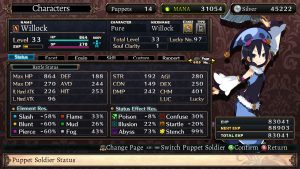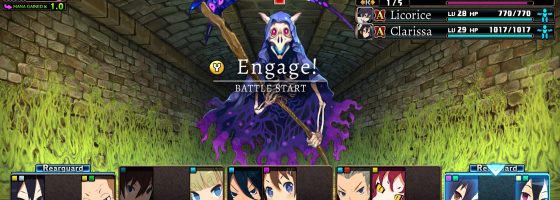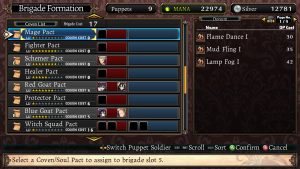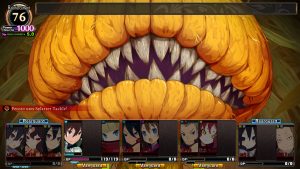Nis America/Nippon Ichi made a name for themselves with the mechanic and system heavy Disgaea franchise and have been since trying to find a suitable follow up franchise. Last year in the US we got Labyrinth of Refrain and I finally had a chance to go through it. What we have is their take on the dungeon crawler which hits more than it misses.
Puppet Theater:
The story of the game follows a mysterious witch and her ward who have arrived at a town with a strange dungeon hidden inside of a well. And while you may assume that they’re going to explore it, it turns out that you’re going to be one who gets to do it. In a flashback, we find out that we’re trapped inside a magical book owned by the witch and we’re forced to do her bidding.
For fans of the craziness of the Disgaea storylines, then you should feel right at home here. There is a lot of “fan service” for people who aren’t comfortable with it, and very suggestive dialogue, but you can skip cutscenes and it doesn’t factor into the gameplay.
For modern fans, the closest analog to Labyrinth of Refrain would be the amazing Etrian Odyssey series which also has you assembling a party of puppet soldiers to go into dungeons with. Where Nippon Ichi differs is how much the party structure becomes its own game system.
Brigading Around
This is where Labyrinth of Refrain does get a bit confusing in terms of gameplay. In order to explore the dungeon, you need to set brigades in which a party can have up to five active. The brigades are created by using “pacts.” A pact can have slots for up to three active members and five support. Pacts can have special skills and attacks assigned to them, and they’re the only way that you can use special abilities during combat.
You’ll need to create characters that can be assigned to one of six classes. The classes determine stat growth, best weapons to use, and what passives they’ll get access to.
The brigade system gives you a lot of flexibility and choices when it comes to party dynamics, and it only grows with the introduction of new battle tactics and pacts.
From there, Labyrinth of Refrain really shines when it comes to the actual dungeon crawling and how active it is compared to its peers.
Dungeon Punching
In most dungeon crawlers, the dungeons themselves are simply there to keep you from your destination and to get into fights with the random encounters. Here, Labyrinth of Refrain features one of the most active systems for dungeon crawling I’ve seen.
This comes in the form of special powers you can unlock that can affect the field. One allows you to punch through walls to find shortcuts, hidden areas, or get around enemy encounters. While enemies are patrolling around, if you can interact with them from the side or back you can get first strike advantage.
Mana can be found in the dungeon that high amounts can make things very bad for you, but it also raises the item drop rate and quality of items you can find. These powers and additional functionality are tied to the game’s reinforcement system.
You have a pool of points that you can use while in the dungeon. Besides activating the as-for-mentioned powers, they can be used to apply buffs during combat, take command of your units, and heal and revive outside of combat. Managing your reinforcement points is important for having any chance at fighting some of the bosses or elite enemies.
With all things combined, I really enjoyed playing Labyrinth of Refrain, but there are some major issues both old and new to Nippon Ichi’s formula.
Tangled Strings:
To understand the problems with the game, it also means understanding Nippon Ichi’s approach to their titles. Starting from Disgaea which brought them into Western audiences, their games have been systems-heavy: allowing players to spend hours fine-tuning and optimizing the way they play.
However, this depth comes at a cost to playability. To this day, each one of their games have been terrible to some extent when it comes to the new player experience. From lackluster tutorials, hard to follow UIs, and just the general gameplay loop is not easily explained.
The sub-systems of a Nippon Ichi game can vary between just for the super high-level players, to be the difference between winning or losing the game.
Labyrinth of Refrain in that regard is no different. Fail to understand how different weapon types work, building your brigades, and spells, and you have no hope of beating the game. The issue is that the game goes out of its way to hide that information from you.
The UI does not give you information such as what stats do, the use of spells unless you are in combat, to even what the different weapons do. One of the most baffling exclusions is not listing a class’s primary stat on their very own status page.
This lack of information also extends to combat and the completely polarizing situations I ran into. Playing on the hardest difficulty, all my battles ended one of two ways:
- The enemy group barely hurt me, and I beat them easily
- The enemy was so strong that it was one-shotting all but my tank puppets
Boss fights grow nastier the further you get into the game, and your chance to overcome them is completely up to RNG.
Pact Problems:
Stats, as with any Nippon Ichi game, are the most important detail to surviving, and gear plays a huge role in it. As with previous games, loot generation is procedural with different rarities to look for. The difference between common and legendary gear is massive — to one point not needing to replace a slotted item for 10 hours of play.

while stats are obviously important, the game doesn’t do a good job of explaining them to the player
Pacts can also be found in treasure chests, earned from quests, or dropped randomly in the dungeon. The problem is that this creates a huge swing in terms of difficulty based on the luck of the player. Not only that, but luck also factors in when it comes to enemies scoring critical, and puppet damaging, attacks. Have a puppet lose their arms during a boss fight and say goodbye to their usefulness. The only way to repair them is to head back to the town and spend money.
For me, thanks to high item drop chances in part to hoarding mana, I had my whole party decked out with legendary gear. However, I was not finding any new pacts which limited my ability to heal, and more importantly, hit enemies with their weaknesses. While basic attacks can help, special abilities from pacts do more damage and are important for dealing with groups of enemies easily.
I’m surprised that I couldn’t find a way to buy pacts, or do something with the copies I found of similar low-quality ones. This is by far the most important system of the game, but isn’t as engaging as I would have liked due to the simplistic and RNG-nature of it.
This problem with pacing can also be felt with the general play of the game. There are many objectives for you to complete; usually involving collecting items or beating a boss. You would think that every time you get an alert to report back to base that it would mean something new was unlocked, but that happens more rarely than it should.
While exploring the game’s fifth dungeon, I apparently moved the story along without finding major characters, and there was no indication about what the next objective was.
The systems of the game are more confusing than deep and feel kind of barebones next to the layers of depth in Nippon Ichi’s other games. The individual characters and classes don’t afford a lot of customization, and the game’s overall tactics are nowhere near as interesting as Etrian Odyssey.
Labyrinth falls back too often on telling the player to explore without any clues or general direction. This is one of those games where missing one door or switch could mean spending hours stuck and not sure where to go.
No Strings on Me
Overall, Labyrinth of Refrain is a good first game foundation for Nippon Ichi. Now, there is a sequel out in Japan that I hope we see over here. If you’re a fan of dungeon crawlers and can put up with the grind and nature of Nippon Ichi’s games, then you’re going to enjoy this one. And as with their other games, if you’re new to the genre, this is not the place to start.




